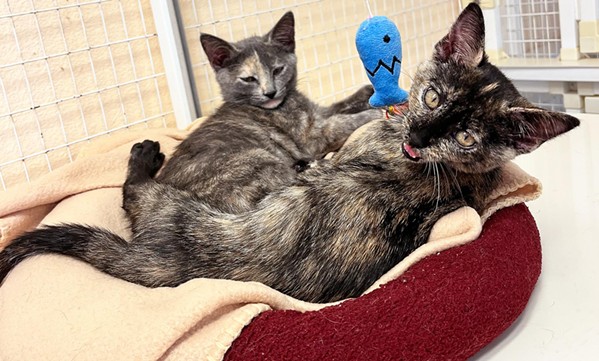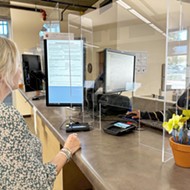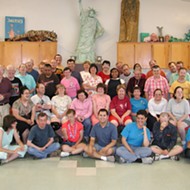[{
"name": "Newsletter Promo",
"id": "NewsletterPromo",
"class": "inlineCenter",
"insertPoint": "4",
"component": "15264767",
"requiredCountToDisplay": "0"
},{
"name": "Ad - Medium Rectangle CC01 - 300x250",
"id": "AdMediumRectangleCC01300x250",
"class": "inlineCenter",
"insertPoint": "8",
"component": "2963441",
"requiredCountToDisplay": "12"
},{
"name": "Ad - Medium Rectangle LC01 - 300x250",
"id": "AdMediumRectangleCC01300x250",
"class": "inlineCenter",
"insertPoint": "18",
"component": "2963441",
"requiredCountToDisplay": "22"
},{
"name": "Ad - Medium Rectangle LC09 - 300x250",
"id": "AdMediumRectangleLC09300x250",
"class": "inlineCenter",
"insertPoint": "28",
"component": "3252660",
"requiredCountToDisplay": "32"
}]
The Cal Poly Cat Program recently requested more community volunteers now that the university's students—and volunteers—have left for the summer.
Shelter Manager Meili Laiho said the program relies heavily on volunteers and with less help, the bandwidth for care has decreased. This caused the shelter to halt its intakes.
The program can begin taking in new cats again once the facility has more support to provide the animals with the services they need.
"We view it as being kind of irresponsible if we were to just keep taking in cats," Laiho said. "We know these cats won't be getting their litter box cleaned every few hours and making sure they're clean."
The nonprofit cat program is a no-kill shelter that's been running since 1992 and has placed more than 3,000 cats in homes. In addition to adoption services, it offers fostering, a sanctuary for cats with declining health, and a trap, neuter, and release (TNR) program to help alleviate feral cat reproduction.
According to Laiho, the shelter sees about 400 student volunteers per year with five volunteers scheduled for each morning, afternoon, and evening shift placing the shelter at capacity for volunteers.
"With that large number of Cal Poly students, every single one of the days is completely booked during the school year," she said.
Summer represents a big shift.
Where once there were five volunteers per time slot, the shelter now sees one to two, and the duties once completed by five people are now a much larger task for the remaining couple of volunteers. This is a gap the shelter encouraged the community to fill.
Laiho said the shelter can work around volunteers' schedules, and they've seen families and groups volunteer together during summer times off.
There are three volunteer shifts daily—morning, afternoon, and evening—ranging from two to three hours, and duties fall under socialization, cleaning, TNR, and medication distribution.
While some cats are prescribed medication for various conditions, volunteers are not expected to medicate the cats, but they work with the one trained medic present per shift to ensure each cat's medical needs are met.
Shelter medic and volunteer Laura Fung, a recently graduated animal science major from Cal Poly, started at the cat program her last quarter and said the it's a great way to get to know people in the community, and the cats help to "break the ice."
As Laura finished her last shift at the shelter, she reflected on her relationships with the cats and their personalities, describing resident cats Franny as friendly and outgoing and Piña as shy.
"It's like meeting a new friend," she said. "I hope people, if they are around, have a chance to come visit."
Community volunteer Dana Humphreys has been involved with the cat program for six years and said volunteering at the shelter gives her and others a feeling of purpose.
"It's a lot of work but a lot of fun," she told New Times.
However, Humphreys also said she felt the community doesn't know about the program and she's exploring ways to get the word out.
"I want to let people know we are here," she said.
Humphreys said the shelter is also in high need of foster homes and donations from the community, and she mentioned that nearly every cat in the facility is adoptable.
For cats needing medical attention or requiring special care, Humphreys said the program does not discriminate.
The program's self-named mascot, Kiwi, has lived at the shelter for 10 years after a history of abuse. Humphreys described Kiwi's care regimen as nearly constant with attention, cleaning, and medication after a recent diagnosis of leukemia.
The program has also cared previously for a 22-year-old cat who was eventually adopted. Other animals are being fed special medicated foods, and if they end up needing extensive, long-term care, they're admitted to the sanctuary and are fully provided for.
Caring for cats from all walks of life is not cheap. According to shelter manager Laiho, the shelter spends on average $300 per cat accepted into the facility.
"We are asking the community to step up and give us a hand," Humphreys said.
To find out more about the Cal Poly Cat Program, visit calpolycatprogram.org or reach out to [email protected].
Fast fact
• The Marian Regional Medical Center Foundation recently presented a $10,000 fund-matching check to the Neonatal Intensive Care Unit at Marian Regional Medical Center to acquire car seats for underserved families within the unit. After the Grower-Shipper Association of Santa Barbara and San Luis Obispo Counties organized a matching gift campaign with its partners, they doubled a $5,000 donation from Driscoll's, the global leader for fresh fruits. Δ
Reach Staff Writer Libbey Hanson at [email protected].










